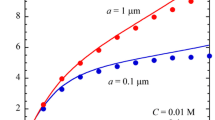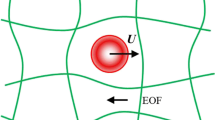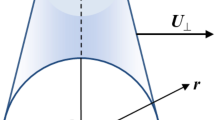Abstract
The magnitude of the electrophoretic mobility μ of a spherical colloidal particle in an electrolyte solution with κa > 3 (κ = the Debye-Hückel parameter of the electrolyte solution and a = particle radius), when plotted as a function of the particle zeta potential ζ, exhibits a maximum μ max at ζ = ζ max. Analytic expressions applicable for large κa (κa ≥ 30) are derived for μ max and ζ max for a spherical particle in a symmetrical electrolyte solution. Analytic expressions for μ max and ζ max are also derived for a spherical particle in a 2:1 or 1:2 electrolyte solution. Finally, it is to be noted that μ max and ζ max for a cylindrical particle of radius a when the particle is oriented perpendicular to the applied electric field are the same as those for a spherical particle of radius a for large κa (κa ≥ 30).
Similar content being viewed by others
Explore related subjects
Discover the latest articles, news and stories from top researchers in related subjects.Avoid common mistakes on your manuscript.
Introduction
A number of theoretical studies have been made on the electrophoretic mobility of a charged colloidal particle in an electrolyte solution [1–25]. It is known that the magnitude of the electrophoretic mobility μ of a spherical colloidal particle with κa > 3 (κ = the Debye-Hückel parameter of the electrolyte solution and a = particle radius), when plotted as a function of the particle zeta potential ζ, exhibits a maximum μ max at a certain value of ζ, which we denote to be ζ max [6–11] (Fig. 1). The appearance of the mobility maximum is due to the relaxation effect. With further increase in zeta potential, the electrophoretic mobility tends to a non-zero limiting electrophoretic mobility, which was treated in detail in refs. [18] and [19]. The purpose of the present paper is to derive analytic expressions for μ max and ζ max. We employ approximate mobility expressions for a charged sphere derived in ref. [20], which are applicable for all values of zeta potentials and large particle radii a such that κa > 30 and have been applied to analyze the mobility of spherical particles with high zeta potentials [26–28].
Theory
Consider a spherical particle of radius a and zeta potential ζ moving with a velocity U under an external electric field E in a symmetrical electrolyte solution of valence z. The electrophoretic mobility μ of the particle is defined by μ = U/E, where U = |U| and E = |E|. In a previous paper [20], we have derived the following general mobility expression, which is correct to the order of exp(ze∣ζ∣/2kT)/κa, where z is the valence of counter ions, e is the elementary electric charge, k is Boltzmann’s constant, T is the absolute temperature, and κ is the Debye-Hückel parameter, so that it is applicable for all values of ζ at large κa (κa ≥ 30):
or its magnitude is given by
with
where the minus and plus signs in Eq. (1) are used for positive and negative zeta potentials, respectively; λ is the drag coefficient of counterions; m is the scaled drag coefficient, which is further related to the limiting equivalent conductance Λ0 of counterions; N A is Avogadro’s number; ε r and η are, respectively, the relative permittivity and the viscosity of the electrolyte solution; and ε o is the permittivity of a vacuum. Note that F given by Eq. (3) corresponds to Dukhin’s number.
For high ζ, where the magnitude of μ reaches a maximum, Eq. (2) is approximated by
The value of ζ at which μ reaches a maximum, which we denote by ζ max, is derived from the condition dμ/dζ = 0 with the result that
which gives
where W(x) is the Lambert W function (or the product logarithm) and satisfies x = W(x)e W(x). By substituting Eq. (7) into Eq, (5), we have the following approximate expression for the maximum value μ max of the electrophoretic mobility μ:
In Eqs. (7) and (8), the plus and minus signs are used for positive and negative zeta potentials, respectively. Equations (7) and (8) are the required expressions for μ max and ζ max.
Results and discussion
We have derived approximate analytic Eqs. (7) and (8) for the maximum μ max and its position ζ max of the magnitude of the electrophoretic mobility μ of a spherical particle of radius a and zeta potential ζ in a symmetrical electrolyte solution of valence z. These expressions are derived on the basis of Eq. (5) (or Eqs. (1) and (2)). Some examples of the calculation of the electrophoretic mobility μ for a negatively charged spherical particle for κa = 50 in an aqueous electrolyte solution with z = 1, 2, and 3 at 25 °C obtained from Eq. (1) are shown in Fig. 1. Figure 1 shows the scaled electrophoretic mobility E m = (3ηe/2ε r ε o kT)μ plotted as a function of the scaled zeta potential eζ/kT. The results obtained from Eq. (5) are also plotted as dotted lines in Fig. 1, which agree with the results of Eq. (1) with negligible errors. As counterions, we have chosen K+, Mg2+, and La3+ ions for the cases of z = 1, 2, and 3, respectively. We use the following values of Λ0 and m: Λ0 = 73.5 × 10−4 m2 Ω−1 equiv−1 and m = 0.176 for K+ ions, Λ0 = 53.1 × 10−4 m2 Ω−1 equiv−1 and m = 0.122 for Mg2+ ions, and Λ0 = 69.6 × 10−4 m2 Ω−1 equiv−1 and m = 0.0618 for La3+ ions (Note that the values of Λ0 and m for Mg2+ ions given in ref. [25] are incorrect and should be replaced by the above values). The numerical values of the scaled mobility maximum defined by E max m = (3ηe/2ε r ε o kT)μ max and the scaled zeta potential zeζ max/kT (at which μ = μ max) are (zeζ max/kT, E max m ) = (5.470, 5.249) for z = 1, (2.793, 2.714) for z = 2, and (1.913, 1.886) for z = 3, while the values obtained from Eqs. (7) and (8) are (zeζ max/kT, E max m ) = (5.490, 5.235) for z = 1, (2.803, 2.705) for z = 2, and (1.919, 1.879) for z = 3, showing that Eqs. (7) and (8) are excellent approximations with negligible errors (less than 0.4 %).
It follows from Eqs. (7) and (8) that ζ max and E max m are both inversely proportional to the valence z of counterions, that is,
as is seen in Fig. 2. It also follows from Eqs. (7) and (8) that ζ max and E max m are both proportional to ln(κa) for large κa, that is
Scaled electrophoretic mobility E m = (3ηe/2ε r ε o kT)μ of a negatively charged spherical particle of radius a and zeta potential ζ(ζ < 0) in an aqueous symmetrical electrolyte solution for three values of the valence of counterions z = 1, 2, and 3 as functions of scaled zeta potential eζ/kT. The values of the reduced ionic drag coefficients for Na+, Mg2+, and La3+ are used as those of counterions for z = 1, 2, and 3, respectively. Calculated with Eq. (1) at κa = 50 and 25 °C. The dotted lines are approximate results obtained from Eq. (5)
as is actually seen in Figs. 3, 4, and 5. Figure 3 shows the dependence of the electrophoretic mobility μ upon κa, and Figs. 4 and 5 give the κa dependence of ζ max and E max m , respectively.
Scaled electrophoretic mobility E m = (3ηe/2ε r ε o kT)μ of a negatively charged spherical particle of radius a and zeta potential ζ(ζ < 0) in an aqueous 1:1 symmetrical electrolyte solution for three values κa plotted as a function of scaled zeta potential eζ/kT. The value of the reduced ionic drag coefficient m (=0.176) for Na+ is used as that of counterions. Calculated with Eq. (1) at κa = 50, 100, and 200 at 25 °C
eζ max/kT as a function of κa calculated with Eq. (7) for z = 1, 2, and 3 at 25 °C
E m max as a function of κa calculated with Eq. (8) for z = 1, 2, and 3 at 25 °C
Similar expressions for ζ max and E max m for the case of a spherical particle in 2:1 or 1:2 electrolyte solutions can be derived on the basis of the approximate mobility expressions given in ref. [20]. The results are given below.
-
(i)
For a positively charged particle (ζ > 0) in a 2:1 electrolyte solution, the electrophoretic mobility μ is given by
$$ \mu =\frac{\varepsilon_r{\varepsilon}_o}{\eta}\left\{\zeta -\frac{2F}{1+F}\left(\frac{kT}{e}\right) \ln \left[\frac{1}{2}+\frac{1}{2}\sqrt{\frac{2}{3} \exp \left(\frac{e\zeta }{kT}\right)+\frac{1}{3}}\right]\right\} $$(11)with
$$ F=\frac{\sqrt{6}}{\kappa a}\left(1+3{m}_{-}\right)\left\{ \exp \left(\frac{e\zeta }{2kT}\right)-1\right\},\kern1em {m}_{-}=\frac{2{\varepsilon}_{\mathrm{r}}{\varepsilon}_{\mathrm{o}}kT}{3\eta {e}^2}{\lambda}_{-}=\frac{2{N}_{\mathrm{A}}{\varepsilon}_{\mathrm{r}}{\varepsilon}_{\mathrm{o}}kT}{3\eta {\varLambda}_{-}^0} $$(12)where λ − and Λ 0− are, respectively, the drag coefficient and limiting equivalent conductance of counterions (anions of valence −1) and m − is the scaled drag coefficient. From Eq. (11), we obtain
$$ {\zeta}_m=\left(\frac{2kT}{e}\right)\left\{W\left(\frac{\kappa a}{6\left(1+3{m}_{-}\right) \exp (1)}\right)+1+\frac{1}{2} \ln (6)\right\} $$(13)$$ {\mu}_{\max }=\frac{\varepsilon_{\mathrm{r}}{\varepsilon}_{\mathrm{o}}}{\eta}\left(\frac{2kT}{e}\right)\left\{W\left(\frac{\kappa a}{6\left(1+3{m}_{-}\right) \exp (1)}\right)+\frac{1}{2} \ln (6)\right\} $$(14) -
(ii)
For a negatively charged particle (ζ < 0) in a 2:1 electrolyte solution, the electrophoretic mobility μ is given by
$$ \mu =\frac{\varepsilon_r{\varepsilon}_{\mathrm{o}}}{\eta}\left\{\zeta +\frac{2F}{1+F}\left(\frac{kT}{e}\right)\right. \ln \left[\frac{1}{2} \exp \left(\frac{e\left|\zeta \right|}{2kT}\right)+\frac{1}{2}\sqrt{\frac{1}{3} \exp \left(\frac{e\left|\zeta \right|}{kT}\right)+\frac{2}{3}}\right] $$(15)with
$$ F=\frac{\sqrt{3}}{\kappa a}\left(1+3{m}_{+}\right)\left\{ \exp \left(\frac{e\left|\zeta \right|}{kT}\right)-1\right\},\kern1em {m}_{+}=\frac{\varepsilon_{\mathrm{r}}{\varepsilon}_{\mathrm{o}}kT}{6\eta {e}^2}{\lambda}_{+}=\frac{N_{\mathrm{A}}{\varepsilon}_{\mathrm{r}}{\varepsilon}_{\mathrm{o}}kT}{3\eta {\varLambda}_{+}^0} $$(16)where λ + and Λ 0+ are, respectively, the drag coefficient and limiting equivalent conductance of counterions (cations of valence +2) and m + is the scaled quantity. From Eq. (15), we obtain
$$ {\zeta}_{\max }=-\left(\frac{kT}{e}\right)\left\{W\left(\frac{\kappa a\left(3+2\sqrt{3}\right)}{18\left(1+3{m}_{+}\right) \exp (1)}\right)+1+2 \ln \left(\frac{2}{1+1/\sqrt{3}}\right)\right\} $$(17)$$ {\mu}_{\max }=-\frac{\varepsilon_{\mathrm{r}}{\varepsilon}_{\mathrm{o}}}{\eta}\left(\frac{kT}{e}\right)\left\{W\left(\frac{\kappa a\left(3+2\sqrt{3}\right)}{18\left(1+3{m}_{+}\right) \exp (1)}\right)+2 \ln \left(\frac{2}{1+1/\sqrt{3}}\right)\right\} $$(18) -
(iii)
For a positively charged sphere (ζ > 0) in a 1:2 electrolyte solution, the electrophoretic mobility μ is given by
$$ \mu =\frac{\varepsilon_{\mathrm{r}}{\varepsilon}_{\mathrm{o}}}{\eta}\left\{\zeta -\frac{2F}{1+F}\left(\frac{kT}{e}\right)\right. \ln \left.\left[\frac{1}{2} \exp \left(\frac{e\zeta }{2kT}\right)+\frac{1}{2}\sqrt{\frac{1}{3} \exp \left(\frac{e\zeta }{kT}\right)+\frac{2}{3}}\right]\right\} $$(19)with
$$ F=\frac{\sqrt{3}}{\kappa a}\left(1+3{m}_{-}\right)\left\{ \exp \left(\frac{e\zeta }{kT}\right)-1\right\},\kern1em {m}_{-}=\frac{\varepsilon_{\mathrm{r}}{\varepsilon}_{\mathrm{o}}kT}{6\eta {e}^2}{\lambda}_{-}=\frac{N_{\mathrm{A}}{\varepsilon}_{\mathrm{r}}{\varepsilon}_{\mathrm{o}}kT}{3\eta {\varLambda}_{-}^0} $$(20)where λ − and Λ 0− are, respectively, the drag coefficient and limiting equivalent conductance of counterions (anions of valence −2) and m − is the scaled quantity. From Eq. (19), we obtain
$$ {\zeta}_{\max }=\left(\frac{kT}{e}\right)\left\{W\left(\frac{\kappa a\left(3+2\sqrt{3}\right)}{18\left(1+3{m}_{-}\right) \exp (1)}\right)+1+2 \ln \left(\frac{2}{1+1/\sqrt{3}}\right)\right\} $$(21)$$ {\mu}_{\max }=\frac{\varepsilon_{\mathrm{r}}{\varepsilon}_{\mathrm{o}}}{\eta}\left(\frac{kT}{e}\right)\left\{W\left(\frac{\kappa a\left(3+2\sqrt{3}\right)}{18\left(1+3{m}_{-}\right) \exp (1)}\right)+2 \ln \left(\frac{2}{1+1/\sqrt{3}}\right)\right\} $$(22) -
(iv)
For a negatively charged sphere (ζ < 0) in a 1:2 electrolyte solution
$$ \mu =\frac{\varepsilon_{\mathrm{r}}{\varepsilon}_{\mathrm{o}}}{\eta}\left\{\zeta +\frac{2F}{1+F}\left(\frac{kT}{e}\right) \ln \left[\frac{1}{2}+\frac{1}{2}\sqrt{\frac{2}{3} \exp \left(\frac{e\left|\zeta \right|}{kT}\right)+\frac{1}{3}}\right]\right\} $$(23)with
$$ F=\frac{\sqrt{6}}{\kappa a}\left(1+3{m}_{+}\right)\left\{ \exp \left(\frac{e\left|\zeta \right|}{2kT}\right)-1\right\},\kern1em {m}_{+}=\frac{2{\varepsilon}_{\mathrm{r}}{\varepsilon}_{\mathrm{o}}kT}{3\eta {e}^2}{\lambda}_{+}=\frac{2{N}_{\mathrm{A}}{\varepsilon}_{\mathrm{r}}{\varepsilon}_{\mathrm{o}}kT}{3\eta {\varLambda}_{+}^0} $$(24)where λ + and Λ 0+ are, respectively, the drag coefficient and limiting equivalent conductance of counterions (cations of valence +1) and m + is the scaled quantity. From Eq. (23), we obtain
$$ {\zeta}_{\max }=-\left(\frac{2kT}{e}\right)\left\{W\left(\frac{\kappa a}{6\left(1+3{m}_{+}\right) \exp (1)}\right)+1+\frac{1}{2} \ln (6)\right\} $$(25)$$ {\mu}_{\max }=-\frac{\varepsilon_{\mathrm{r}}{\varepsilon}_{\mathrm{o}}}{\eta}\left(\frac{2kT}{e}\right)\left\{W\left(\frac{\kappa a}{6\left(1+3{m}_{+}\right) \exp (1)}\right)+\frac{1}{2} \ln (6)\right\} $$(26)Finally, it is to be noted that the electrophoretic mobility of an infinitely long cylindrical particle of radius a in an electric field when the particle axis is oriented perpendicular to the applied electric field coincides with that of a spherical particle of radius a provided that κa is large (κa ≥ 30) [29]. Thus, the expressions for ζ max and E max m obtained above hold good also for κa ≥ 30.
Conclusion
We have derived simple approximate analytic expressions for the maximum μ max of the magnitude of the electrophoretic mobility μ of a charged spherical colloidal particle of radius a and zeta potential ζ in an electrolyte solution and the zeta potential ζ max that gives μ = μ max. The obtained expressions are derived on the basis of approximate expressions of the electrophoretic mobility which take into account the relaxation effect. These expressions, which are obtained by neglecting terms of order 1/κa in the general mobility expression and correct to the order of exp(ze∣ζ∣/2kT)/κa (where z is the valence of counterions), are applicable for all values of zeta potential at large κa (κa ≥ 30). It is shown that ζ max∝ 1/z and μ max∝ 1/z, and it is also shown that ζ max∝ ln(κa) and μ max∝ ln(κa) for large κa. The corresponding expressions are also derived for a sphere in a 2:1 or 1:1 electrolyte solution. It is to be noted that the results for a cylindrical particle of radius a when the particle is oriented perpendicular to the applied electric field are the same as those for a spherical particle of radius a provided that κa is large (κa ≥ 30). Finally, it is to be mentioned that the existence of μ max at large κa becomes important also in micro-fluidic applications (see e.g., [30]).
References
von Smoluchowski M (1921) Elektrische endosmose und strömungsströme. In: Greatz E (ed) Handbuch der Elektrizität und des Magnetismus, Band II Stationäre ströme p. Barth, Leipzig, pp 366–428
Hückel E (1924) Die kataphorese der kugel. Phys Z 25:204–210
Henry DC (1931) The cataphoresis of suspended particles. Part I. The equation of cataphoreis. Proc Roy Soc London Ser A 133:106–129
Overbeek JTG (1943) Theorie der Elektrophorese. Kolloid Beih 54:287–364
Booth F (1950) The cataphoresis of spherical, solid non-conducting particles in a symmetrical electrolyte. Proc R Soc London Ser A 203:514–533
Dukhin SS, Semenikhin NM (1970) Theory of double layer polarization and its influence on the electrokinetic and electrooptical phenomena and the dielectric permeability of disperse systems. Calculation of the electrophoretic and diffusiophoretic mobility of solid spherical particles. Kolloidn Zh 32:360–368
Dukhin SS, Derjaguin BV (1974) Nonequilibrium double layer and electrokinetic phenomena. In: Matievic E (ed) Surface and Colloid Science, vol 2. John Wiley & Sons, Hoboken, pp 273–336
O'Brien RW, White LR (1978) Electrophoretic mobility of a spherical colloidal particle. J Chem Soc Faraday Trans 2 74:1607–1626
O'Brien RW, Hunter RJ (1981) The electrophoretic mobility of large colloidal particles. Can J Chem 59:1878–1887
Ohshima H, Healy TW, White LR (1983) Approximate analytic expressions for the electrophoretic mobility of spherical colloidal particles and the conductivity of their dilute suspensions. J Chem Soc Faraday Trans 2 79:1613–1628
O'Brien RW (1983) The solution of the electrokinetic equations for colloidal particles with thin double layers. J Colloid Interface Sci 92:204–216
van de Ven TGM (1989) Colloid hydrodynamics. Academic Press, New York
Dukhin SS (1993) Non-equilibrium electric surface phenomena. Adv Colloid Interface Sci 44:1–134
Ohshima H (1994) A simple expression for Henry’s function for the retardation effect in electrophoresis of spherical colloidal particles. J Colloid Interface Sci 168:269–271
Ohshima H, Furusawa K (eds) (1998) Electrical phenomena at interfaces, fundamentals, measurements, and applications, 2nd edition, revised and expanded. Dekker, New York
Delgado AV (ed) (2000) Electrokinetics and electrophoresis. Dekker, New York
Ohshima H (2001) Approximate analytic expression for the electrophoretic mobility of a spherical colloidal particle. J Colloid Interface Sci 239:587–597
Ohshima H (2003) On the limiting electrophoretic mobility of a highly charged colloidal particle in an electrolyte solution. J Colloid Interface Sci 263:337–340
Ohshima H (2004) Electrophoretic mobility of a highly charged colloidal particle in a solution of general electrolytes. J Colloid Interface Sci 275:665–669
Ohshima H (2005) Approximate expression for the electrophoretic mobility of a spherical colloidal particle in a solution of general electrolytes. Colloids Surf A Physicochem Eng Asp 267:50–55
Spasic A, Hsu J-P (eds) (2005) Finely dispersed particles. Micro-. Nano-, Atto-Engineering, CRC Press, Boca Raton
Ohshima H (2006) Theory of colloid and interfacial electric phenomena. Elsevier, Amsterdam
Ohshima H (2010) Biophysical chemistry of biointerfaces. John Wiley & Sons, Hoboken
Ohshima H (ed) (2012) Electrical phenomena at interfaces and biointerfaces: fundamentals and applications in nano-, bio-, and environmental sciences. John Wiley & Sons, Hoboken
Ohshima H (2014) Simple approximate analytic expression for the electrophoretic mobility of a spherical colloidal particle in a mixed solution of 1:1 and 2:1 electrolytes. Colloid Polym Sci 292:1457–1461
Kobayashi M (2008) Electrophoretic mobility of latex spheres in the presence of divalent ions: experiments and modeling. Colloid Polym Sci 286:935–940
Chassagne C, Ibanez M (2013) Electrophoretic mobility of latex nanospheres in electrolytes: experimental challenges. Pure Appl Chem 85:41–51
Kobayashi M, Sasaki A (2014) Electrophoretic mobility of latex spheres in mixture solutions containing mono and divalent counter ions. Colloids Surf A Physicochem Eng Asp 440:74–78
Ohshima H (2014) Approximate analytic expression for the electrophoretic mobility of a cylindrical colloidal particle. Relaxation effect. Colloid Polym Sci 292:1227–1233
Sugioka H (2014) dc step response of induced-charge electro-osmosis between parallel electrodes at large voltages. Phys Rev E 90:013007
Author information
Authors and Affiliations
Corresponding author
Rights and permissions
About this article
Cite this article
Ohshima, H. On the maximum of the magnitude of the electrophoretic mobility of a spherical colloidal particle in an electrolyte solution. Colloid Polym Sci 294, 13–17 (2016). https://doi.org/10.1007/s00396-015-3756-8
Received:
Revised:
Accepted:
Published:
Issue Date:
DOI: https://doi.org/10.1007/s00396-015-3756-8









